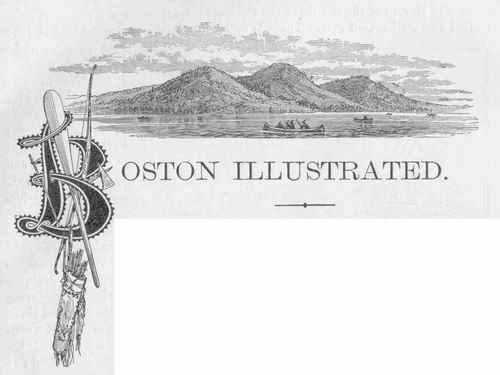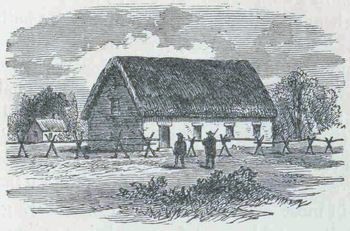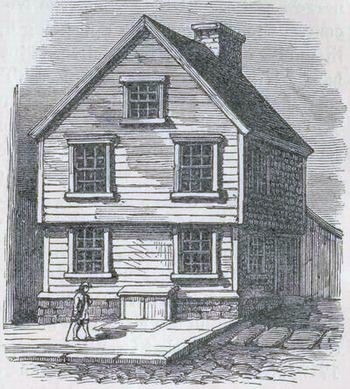|
Click Here to return to
Content Page
|
(HOME)
|
|
Click Here to return to
Content Page
|
(HOME)
|
 I. A GLANCE AT ITS HISTORY. BOSTON was originally “by the Indians called Shawmutt,” but the colonists of 1630, wandering southward from their landing-place at Salem, named it Trimountaine. Charlestown, which was occupied by them in July, 1630, was speedily abandoned because there was found no good spring of water, and the peninsula close by haying been bought of its sole white inhabitant, Mr. William Blaxton, or Blackstone, an Englishman, who had been living there several years, the settlement was transferred thither on the 7th of September, O. S. (17th N. St). On the same day the court held at Charlestown ordered that Trimountaine be called Boston. This name was given to it in memory of Boston in Old England, from which many of the colonists had emigrated, and which was the former home of Mr. Isaac Johnson, next to Governor Winthrop the most important man among the band of immigrants. The name of Trimountaine, which has been transformed into Tremont, was peculiarly appropriate. As seen from Charlestown, the peninsula seemed to consist of three high hills, afterwards named Copp’s, Beacon, and Fort. And the highest of the three was itself a trimountain, having three sharp little peaks. It seems to be agreed that this peculiarity of Beacon Hill was what gave to the place its ancient name. Soon after selling the land to the new company of immigrants, Mr. Blaxton withdrew to the place which now bears his name, the town of Blackstone, on the border of Rhode Island. His house in Boston stood on the slope of Beacon Hill, near where now are Pinckney Street and Louisburg Square. Boston was selected as the centre and metropolis of the Massachusetts Colony. The nucleus of the Colony was large, and the several towns lying along the coast were, considering the circumstances, rapidly settled. During the year 1630 as many as fifteen hundred persons came from England. In ten years not less than twenty thousand had been brought over. In 1639 there was a muster in Boston of the militia of the Colony to the number of a thousand able-bodied and well-armed men. There is authority for the statement that in 1674 there were about fifteen hundred families in the town, and the population of New England was then reckoned at one hundred and twenty thousand.  The early history of Boston has been an almost in-exhaustible field for the researches of local antiquaries. Considering that almost three quarters of a century elapsed before the first newspaper was printed, the material for making a complete account of the events that occurred, and for forming a correct estimate of the habits and mode of life of the people, are remarkably abundant. The records have been searched to go o d purpose. Still it is to visitors that we are indebted for some of the most quaint and interesting pictures of early New England life. An English traveller, named Edward Ward, published in London in 1699 an account of his trip to New England, in which he describes the customs of Bostonians in a lively manner, though parts of the story are evidently exaggerated, Mr. Ward thought it a great hardship that “Kissing a Woman in Publick, tho’ offer’d as a Courteous Salutation,” should be visited with the heavy punishment of whipping for both the offenders. There were even then “stately Edifices, some of which have cost the owners two or three Thousand Pounds sterling,” and this fact Mr. Ward rather illogically conceived to prove the truth of two old adages, “That a Fool and his Money is soon parted; and, Set a Beggar on Horseback he'll ride to the Devil; for the Fathers of these Men were Tinkers and Peddlers.” He seemed to have a very low opinion of the religious and moral character of the people. Mr. Daniel Neal, who wrote a book a few years later, found “the conversation in this town as polite as in most of the cities and towns in England,” and he describes the houses, furniture, tables, and dress as being quite as splendid and showy as those of the most considerable tradesmen in London. Hardly a vestige of the town as it appeared to the earliest settlers now remains. We have, it is true, in a good state of preservation still, the three most ancient burial-grounds of the town, and a few outbuildings; and some of the narrow and crooked streets at the North End have retained their early devious course, though generally appearing upon the map under changed names. But little else of Boston in its first century is preserved. The face of the country has been completely transformed. The hills have been cut down, and the flats surrounding the peninsula have been filled so that it is a peninsula no longer. The old water line has disappeared completely. On the east, the west, and the south, nearly a thousand acres once covered by the tide have been reclaimed, and are now covered with streets, dwellings, and warehouses. Boston was from the first a commercial town. Less than a year had elapsed since the settlement of the town when the first vessel built in the colony was launched. We may infer something in regard to the activity of the foreign and coasting trade from the statement of Mr. Neal, before referred to, that “the masts of ships here, and at proper seasons of the year, make a kind of wood of trees like that we see upon the river of Thames about Wapping and Limehouse;” and the same author says that twenty-four thousand tons of shipping were at that time, 1719, cleared annually from the port of Boston. In 1741 there were forty vessels upon the stocks at one time in Boston, showing that a quick demand for shipping existed at that period. It was not until four years after the settlement of the town that a shop was erected separate from the dwelling of the proprietor. In these early days the merchants of Boston met with many reverses, and wealth was acquired but slowly in New England generally. Nevertheless, the town was on the whole prosperous. At the close of the seventeenth century, Boston was probably the largest and wealthiest town in America, and it has ever since retained its rank among the very first towns on the continent. The colonists brought their minister with them, the Rev. John Wilson, who was ordained pastor of the church in Charlestown, and afterwards of the church in Boston. But the meeting-house was not built until 1632. This building was very small and very plain, within and without. It is believed to have stood nearly on the spot where Brazer’s Building now stands, near the Old State House, in State Street. In 1640 the same society occupied a new, much larger and finer building, which stood on the site now occupied by Roger’s Building on Washington Street. This second edifice stood seventy-one years and was destroyed by fire in 1711; the third, built on the same spot in 1712, was long known as the “Old Brick Church” and stood until 1808, when it was taken down; the fourth was on Chauncy Place; and the fifth is the present very elegant church building on Berkeley Street, first occupied in 1868. Several other churches were established very soon after the “First,” and there are now in existence as many as eight church organizations dating back to the first hundred years after the place was settled. The fathers of the town were sternly religious, outwardly at all events. The evidences are abundant that they were also zealous for education. The influence of Harvard College, in Cambridge, was strong upon Boston from the first; but a public school had been voted by the town in 1635, the year before Harvard was founded.  First Church in Boston. It was in Boston that the first newspaper ever published on the American continent, the “Boston News Letter,” appeared on the 24th of April, 1704. Two years later the first great New England journalist, and afterwards a philosopher, statesman, and diplomatist, was born in a little house that stood near the head of Milk Street, and that is still remembered by some of the oldest citizens of Boston. It was destroyed by fire at the close of the year 1811, after having stood almost a hundred and twenty years. The office of the “Boston Post” now covers the spot.  Birthplace of Benjamin Franklin. |